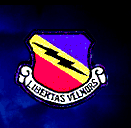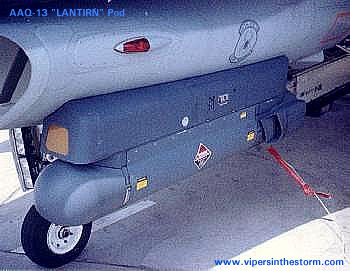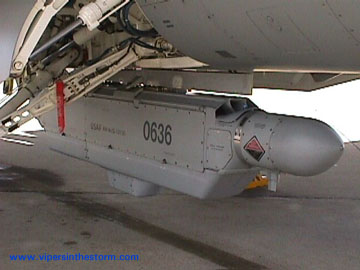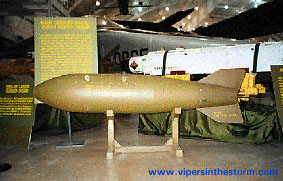 | |||
 | |||
 | |||
 | |||||
[ Page 1 ] [ Page 2 ] [ Page 3 ] [ Page 4 ]
AAQ-13 "LANTIRN" Pod
The AAQ-13 LANTIRN (Low Altitude Navigation and Targeting Infrared for Night) pod weighs 442.5 lbs. and is mounted on the left side of the F-16 intake. The pod uses a forward looking infrared (FLIR) sensor that displays an infrared picture to the pilot via the wide-field-of-view head-up (HUD) display and/or either one of the two multifunction displays (MFDs) located on the forward panel. The FLIR imagery is displayed in shades of green and gray, which represent differences in temperature between an object and its background. In addition to the FLIR, LANTIRN incorporates a terrain following radar (TFR) system linked directly to the F-16's autopilot. The system uses airspeed, aircraft angle of attack, radar altimeter altitude, and data from its own signal return to ensure that the aircraft flies at the proper altitude. Several limits, warnings, and cautions are presented in the HUD to protect and advise pilots who approach the edge of the LANTIRN envelope. If a pilot inadvertently exceeds bank angle, turn rate, airspeed, or pitch limits, the aircraft will automatically climb away from the terrain. This event is called a "fly-up." Fly-ups also occur when pilots try to descend too far below their selected set clearance plane, or if they attempt to turn in the direction of terrain without climbing.
ALQ-131 Electronic Countermeasures Pod
The ALQ-131 is an advanced electronic countermeasures (ECM) pod designed to provide aircraft self-protection against enemy radar threats. The ALQ-131 accomplishes this by responding with a combination of noise, repeater, or transponder electronic jamming techniques. The pod weighs 600 lbs., with modular design for multiple frequency band capability. The ECM pod is carried on the center station of the F-16 and has the ability to be quickly re-programmed against changing threats. M-129 Leaflet Bomb
The M-129 leaflet bomb is designed for use in the delivery of leaflet type materials. The bomb body is cylindrical in shape with an ogical nose and a tapered aft section with fins. The bomb body is split longitudinally into two sections, which are held together by four latches on each side. The fuse well in the nose of the weapon accommodates a variety of airburst mechanical fuses. The fuse causes a booster to ignite and detonates a strip of primacord, which in turn separates the two body halves, detaches the fins, and allows the leaflet material to scatter. A single dispenser is 7 feet 6 inches in length, 16 inches in diameter, and weighs approximately 200 lbs.
Proceed to Page 3. | |||||


